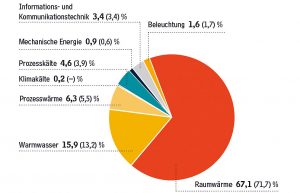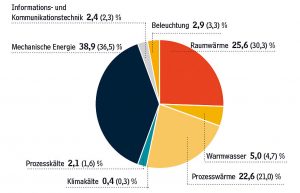
Fig. 1. Final energy consumption of private households by application – shares in percent 2018 (2008). Source: AGEB
The energy demand for heating and lighting in Germany has decreased in the last ten years (Figure 1). According the current calculations by the Working Group on Energy Balances (AG Energiebilanzen), the heating demand in 2018 was 17 % lower than in 2008. A significant proportion of this change is due to temperature differences between the two years. After compensating for temperature, the decrease is at 2 %. The savings for lighting amounted to 14 %. The figures for domestic hot water (6 %) and refrigeration (30 %) rose however. Energy consumption for transport increased by nearly 5 %; information and communication technology required 1.6 % more energy. The AG Energiebilanzen reports that with 8,996 PJ, the demand for final energy in Germany decreased by nearly 2 % overall between 2008 and 2018 as a result of the opposing developments.
More than 53 % of the total final energy consumption in Germany is attributable to heating (Figure 2). The reduction in spatial heating demand was opposed by an increase in demand for process heat in industry and commerce. The available data show that the energy efficiency has significantly increased in both areas. However, the positive economic development of the past years has led to an overcompensation of energy savings for process heat. With roughly 39 %, motoring energy forms the second largest share of the final energy consumption. Domestic hot water, refrigeration, lighting and information and communication technology made up only around 13 % of the total final energy consumption in 2018.

Fig. 2. Final energy consumption in Germany by application – shares in percent 2018 (2008). Source: AGEB
Heating in Germany is mainly provided through gas. With a share of nearly 45 %, this heat source is far more common than mineral oil (14.9 %), renewable energies (11.6 %) as well as coal (9.4 %), electricity (9.3 %) and district heating (8.4 %). In refrigeration and air conditioning, electricity dominates with a share of nearly 98 %. Mechanical energy (transport and stationary engines/motors) is mainly generated from mineral oil (75.4 %) and electricity (20.5 %). Information and communication technology as well as lighting are also powered nearly entirely by electricity.
In terms of application areas for final energy, transport currently holds a share of 30 % with 2,705 PJ overall. Mineral oil continues to dominate consumption in this area with a share of 94 %. Renewable fuels currently take up 4.2 %, while electricity reaches 1.6 % and gas 0.2 %.
The industrial final energy consumption is only slightly below the transport sector with 2,651 PJ. Both gas (35.6 %) and electricity (30.8 %) make up high shares of the industrial final energy consumption. Renewable energies make up only 4.3 %.
Private households consumed 25.5 % or 2,291 PJ of the total final energy in 2018. Here, renewable energies already make up 14.0 %, but this is still significantly lower than mineral oil (19.4 %), gas (37.6 %) and electricity (20.3 %). The smallest application for final energy is the commerce, trade and services sector with 15.0 % of the total energy consumption. This sector uses primarily electricity (38.7 %) as well as oil (21.1 %) and gas (27.5 %).
The energy used by industry, transport, private households and the commerce, trade and services sector together makes up the final energy consumption, which forms part of the energy balance for Germany regularly created by the AG Energiebilanzen. However, the final energy consumption is not actually the last stage of energy use. End consumers (private households, industry, commerce, trade and services, and transport) convert the supplied energy into useful energy or energy services with different techniques.
Since 2014, the AG Energiebilanzen has created usage balances which provide meaningful data for this last stage of conversion on behalf of the Federal Ministry for Economic Affairs and Energy. The creation of these balances is aided by the Fraunhofer Institute for Systems and Innovation Research, the RWI – Leibniz Institute for Economic Research and (until 2017) the Institute for Energy Economy and Application Technology at the Technical University of Munich.
(AGEB/Si.)
